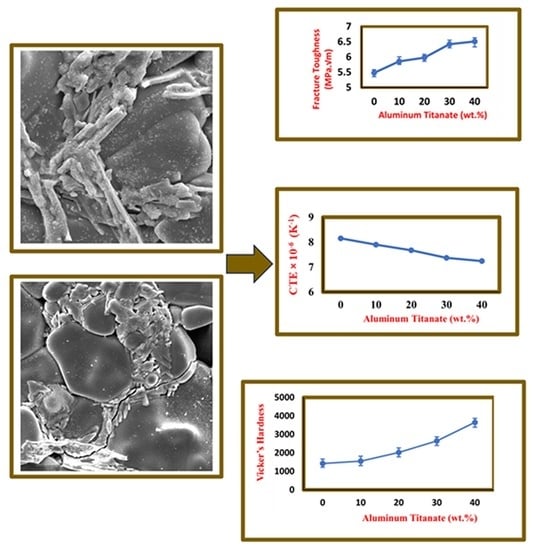Microstructure, Mechanical and Thermal Properties of ZTA/Al2TiO5 Ceramic Composites
Abstract
:1. Introduction
2. Materials and Methods
2.1. Materials and Synthesis Methods
2.2. Characterization
2.3. Mechanical Testing
2.4. Thermal Measurements
3. Results
3.1. Phase Assemblage of the PSZ and Al2TiO5 Ceramics
3.2. Densification of the ZTA/Al2TiO5 Ceramic Composites
3.3. Phase Composition of the ZTA/Al2TiO5 Ceramic Composites
3.4. Microstructure of ZTA/Al2TiO5 Ceramic Composites
3.5. Mechanical and Thermal Properties of the ZTA/Al2TiO5 Ceramic Composites
3.5.1. Three-Point Bending Strength Test Results
3.5.2. Vickers Hardness Measurements
3.5.3. Fracture Toughness
3.5.4. Reversible Thermal Expansion
3.5.5. Thermal Shock Resistance (TSR)
4. Conclusions
Author Contributions
Funding
Institutional Review Board Statement
Informed Consent Statement
Data Availability Statement
Conflicts of Interest
References
- Sarker, S.; Mumu, H.T.; Al-Amin, M.; Alam, M.Z.; Gafur, M.A. Impacts of inclusion of additives on physical, microstructural, and mechanical properties of Alumina and Zirconia toughened alumina (ZTA) ceramic composite: A review. Mater. Today Proc. 2022, 62, 2892–2918. [Google Scholar] [CrossRef]
- Dhar, S.A.; Mumu, H.T.; Sarker, S.; Bazlur Rashid, A.K.M. Influences of sintering time on the structures and mechanical properties of zirconia toughened alumina nanocomposites. Mater. Today Proc. 2021, 44, 1356–1360. [Google Scholar] [CrossRef]
- Naga, S.M.; Awaad, M.; Bondioli, F.; Fino, P.; Hassan, A.M. Thermal diffusivity of ZTA composites with different YSZ quantity. J. Alloys Compd. 2017, 695, 1859–1862. [Google Scholar] [CrossRef]
- Hofer, A.K.; Kraleva, I.; Prötsch, T.; Vratanar, A.; Wratschko, M.; Bermajo, R. Effect of second phase addition of zirconia on the mechanical response of textured alumina ceramics. J. Eur. Ceram. Soc. 2022, 43, 2935–2942. [Google Scholar] [CrossRef]
- Tai, Q.; Mocellin, A. High temperature deformation of Al2O3-based ceramic particle or whisker composites. Ceram. Int. 1999, 25, 395–408. [Google Scholar] [CrossRef]
- Bermejo, R.; Torres, Y.; Llanes, L. Loading configuration effects on the strength reliability of alumina–zirconia multilayered ceramics. Compos. Sci. Technol. 2008, 68, 244–250. [Google Scholar] [CrossRef]
- Yang, Y.; Wang, Y.; Tian, W.; Wang, Z.Q.; Zhao, Y.; Wang, L.; Bian, H.M. Reinforcing and toughening alumina/titania ceramic composites with nano-dopants from nanostructured composite powders. Mater. Sci. Eng. A 2009, 508, 161–166. [Google Scholar] [CrossRef]
- Fu, Y.; Gu, Y.W.; Du, H. SiC whisker toughened Al2O3-(Ti, W) C ceramic matrix composites. Scr. Mater. 2011, 44, 111–116. [Google Scholar] [CrossRef]
- Manshor, H.; Aris, S.; Azhar, A.Z.A.; Abdullah, E.C.; Ahmad, Z.A. Effects of TiO2 addition on the phase, mechanical properties, and microstructure of zirconia-toughened alumina ceramic composite. Ceram. Int. 2015, 41, 3961–3967. [Google Scholar] [CrossRef]
- Wahsh, M.M.S.; Khattab, R.M.; Zawrah, M.F. Sintering and technological properties of alumina/zirconia/nano-TiO2 ceramic composites. Mater. Res. Bull. 2013, 48, 1411–1414. [Google Scholar] [CrossRef]
- Kalita, S.J.; Somani, V. Al2TiO5-Al2O3-TiO2 nanocomposite: Structure, mechanical property and bioactivity studies. Mater. Res. Bull. 2010, 45, 1803–1810. [Google Scholar] [CrossRef]
- Djambazov, S.; Lepkova, D.; Ivanov, I. A study of the stabilization of aluminium titanate. J. Mater. Sci. 1994, 29, 2521–2525. [Google Scholar] [CrossRef]
- Buscaglia, V.; Nanni, P.; Battilana, G.; Aliprandi, G.; Carry, C. Reaction sintering of aluminium titanate: I effect of MgO addition. J. Eur. Ceram. Soc. 1994, 13, 411–417. [Google Scholar] [CrossRef]
- Sobhani, M.; Ebadzadeh, T.; Rahimipour, M.R. Formation and densification behavior of reaction sintered alumina–20 wt.% aluminium titanate nano-composites. Int. J. Refract. Met. Hard Mater. 2014, 47, 49–53. [Google Scholar] [CrossRef]
- Wang, X.T.; Padture, N.P.; Tanaka, H.; Ortiz, A.L. Wear-resistant ultra-fine-grained ceramics. Acta Mater. 2005, 53, 271–277. [Google Scholar] [CrossRef]
- Runyan, J.L.; Bennison, S.J. Fabrication of flaw-tolerant aluminum-titanate reinforced alumina. J. Eur. Ceram. Soc. 1991, 7, 93–99. [Google Scholar] [CrossRef]
- Lawn, B.R.; Padture, N.P.; Braun, L.M.; Bennison, S.J. Model for toughness curves in two phase ceramics: I, Basic fracture mechanics. J. Am. Ceram. Soc. 1993, 76, 2235–2240. [Google Scholar] [CrossRef]
- Padture, N.P.; Runyan, J.L.; Bennison, S.J.; Braun, L.M.; Lawn, B.R. Model for toughness curves in two-phase ceramics: II. Microstructural variables. J. Am. Ceram. Soc. 1993, 76, 2241–2247. [Google Scholar] [CrossRef]
- Ma, Q.; Shan, Q.; Chen, C.; Xu, Q.; Wang, Y.; Zhou, Y.; Shui, A. The influence of ZrO2 on the microstructure and mechanical properties of Al2TiO5 flexible ceramics. Mater. Charact. 2022, 185, 111719–111728. [Google Scholar] [CrossRef]
- Alves, P.C.F.; da Silva, D.G.; Vasconcelos, D.C.L.; Vilela, J.J.; Nascimento, J.F.; de Malo, D.C.; Vasconcelos, W.L. Microstructural characterization and mechanical properties on Al2O3–TiO2 materials obtained by uniaxial pressing and extrusion. Ceram. Int. 2021, 47, 24988–24996. [Google Scholar] [CrossRef]
- Borrell, A.; Salvador, M.D.; Rocha, V.G.; Fernández, A.; Molina, T.; Moreno, R. Enhanced properties of alumina-aluminium titanate composites obtained by spark plasma reaction-sintering of slip cast green bodies. Compos. Part B 2013, 47, 255–259. [Google Scholar] [CrossRef]
- Meybodi, S.M.; Bafrooei, H.B.; Ebadzadeh, T.; Tazike, M. Microstructure and mechanical properties of Al2O3–20 wt% Al2TiO5 composite prepared from alumina and titania nanopowders. Ceram. Int. 2013, 39, 977–982. [Google Scholar] [CrossRef]
- Moritz, K.; Aneziris, C.G. Enhancing the thermal shock resistance of alumina-rich magnesium aluminate spinel refractories by an aluminum titanate phase. Ceram. Int. 2016, 42, 14155–14160. [Google Scholar] [CrossRef]
- Naga, S.M.; Abdelbary, E.M.; Awaad, M.; El-Shaer, Y.I.; Abd-Elwahab, H.S. Effect of the preparation route on the mechanical properties of Yttria–Ceria doped Tetragonal Zirconia/Alumina composites. Ceram. Int. 2013, 39, 1835–1840. [Google Scholar] [CrossRef]
- Naga, S.M.; Awaad, M.; Saleh, A.M.; Hassan, A.M. Formation, Phase Stability, and Characterization of Unstabilized Aluminum Titanate (Al2TiO5) Ceramics. Des. Eng. 2021, 9, 17740–17754. [Google Scholar] [CrossRef]
- Anstis, G.R.; Chantikul, P.; Lawn, B.R.; Marshall, B.D. A critical evaluation of indentation techniques for measuring fracture toughness: I, direct crack measurement. J. Am. Ceram. Soc. 1981, 64, 533–538. [Google Scholar] [CrossRef]
- Tang, D.; Lim, H.; Lee, K.J.; Lee, C.; Cho, W. Evaluation of mechanical reliability of zirconia-toughened alumina composites for dental implants. Ceram. Int. 2012, 38, 2429–2436. [Google Scholar] [CrossRef]
- Prüfung von Keramischen Hochleistungswerkstoffen, Ermittlung der Risszähigkeit KIc (Testing High-Performance Ceramic Materials, Determination of the Fracture Toughness, KIc, in German); Beuth-Verlag: Berlin, Germany, 1991.
- Munz, D.; Fett, T. Ceramics: Mechanical Properties, Failure Behavior, Materials Selection; Springer: Berlin, Germany, 1999. [Google Scholar]
- Sathiyakumar, M.; Gnanam, F.D. Influence of MnO and TiO2 additives on density, microstructure and mechanical properties of Al2O3. Ceram. Int. 2002, 28, 195–200. [Google Scholar] [CrossRef]
- Keyvani, N.; Azarniya, A.; Hosseini, H.R.; Abeidi, M.; Moskovskikh, D. Thermal stability and strain sensitivity of nanostructured aluminum titanate (Al2TiO5). Mater. Chem. Phys. 2019, 223, 202–208. [Google Scholar] [CrossRef]
- Azarniya, A.; Hosseini, H.R.; Amutha, C.; Ramakrishna, A. Effect of nanostructuring on thermal stability and decomposition of aluminium titanate (Al2TiO5): A phase transformation study. Mater. Charact. 2021, 173, 110764–110772. [Google Scholar] [CrossRef]
- De Jonghe, L.C.; Rahaman, M.N. Sintering of Ceramics, Handbook of Advanced Ceramics: Materials, Applications, Processing and Properties; Elsevier Inc.: Amsterdam, The Netherlands, 2003; Volume 1–2, pp. 187–264. [Google Scholar]
- Oishi, Y.; Ando, K.; Sakka, Y. Advances in Ceramics. Am. Ceram. Soc. 1983, 7, 208–219. [Google Scholar]
- Hwang, C.S.; Chang, Y.J. Effects of TiO2 on the microstructure and mechanical properties of Al2O3/ZrO2 composites. J. Mater. Res. 1996, 11, 1545–1551. [Google Scholar] [CrossRef]
- Clement, J.L.; Jarrett, P.S. Antibacterial silver. Met. Based Drugs 1994, 1, 467–482. [Google Scholar] [CrossRef] [PubMed]
- Sotiropoulou, D.; Nikolopoulos, P. Work of adhesion in ZrO2-liquid metal systems. J. Mater. Sci. 1993, 28, 356–360. [Google Scholar] [CrossRef]
- Maki, R.S.; Suzuki, Y. Mechanical strength and electrical conductivity of reactively-sintered pseudobrookite-type Al2TiO5–MgTi2O5 solid solutions. J. Ceram. Soc. Jpn. 2016, 124, 1–6. [Google Scholar] [CrossRef]
- Giordano, L.; Viviani, M.; Bottino, C.; Buscaglia, M.; Buscaglia, V.; Nanni, P. Microstructure and thermal expansion of Al2TiO5–MgTi2O5 solid solutions obtained by reaction sintering. J. Eur. Ceram. Soc. 2002, 22, 1811–1822. [Google Scholar] [CrossRef]
- Ananthakumar, S.; Jayasankar, M.; Warrier, K. Microstructural, mechanical and thermal characterization of sol–gel-derived aluminium titanate–mullite ceramic composites. Acta Mater. 2006, 54, 2965–2973. [Google Scholar] [CrossRef]
- Buessem, W.; Thielke, N.; Sarakauskas, R. Thermal expansion hysteresis of aluminum titanate. Ceram. Age. 1952, 60, 38–40. [Google Scholar]
- Huang, Y.; Wu, D.; Zhao, D.; Niu, F.; Ma, G. Investigation of melt-growth alumina/aluminum titanate composite ceramics prepared by directed energy deposition. Int. J. Extrem. Manuf. 2021, 3, 035101–035116. [Google Scholar] [CrossRef]
- Ewais, E.M.M.; Besisa, N.H.A.; Ahmed, A. Aluminum titanate based ceramics from aluminum sludge waste. Ceram. Int. 2017, 43, 10277–10287. [Google Scholar] [CrossRef]
- Ahmad, I.; Islam, M.; Abdo, H.S.; Subhani, T.; Khalil, K.A.; Almajid, A.A.; Yazdani, B.; Zhu, Y.Q. Toughening mechanisms and mechanical properties of graphene nanosheet-reinforced alumina. Mater. Des. 2015, 88, 1234–1243. [Google Scholar] [CrossRef]
- Chen, G.Q.; Zu, Y.F.; Luo, J.T.; Fu, X.S.; Zhou, W.L. Microstructure and superplastic behavior of TiO2-doped Al2O3–ZrO2 (3Y) composite ceramics. Mater. Sci. Eng. 2012, 554, 6–11. [Google Scholar] [CrossRef]
- Yazdani, B.; Xia, Y.D.; Ahmad, I.; Zhu, Y.Q. Graphene and carbon nanotube (GNT)-reinforced alumina nanocomposites. J. Eur. Ceram. Soc. 2015, 35, 179–186. [Google Scholar] [CrossRef]
- Yin, Y.; Ma, B.Y.; Hu, C.B.; Liu, G.Q.; Li, H.X.; Su, C.; Ren, X.M.; Yu, J.Y.; Zhang, Y.R.; Yu, J.K. Preparation and properties of porous SiC-Al2O3 ceramics using coal ash. Int. J. Appl. Ceram. Technol. 2019, 16, 23–31. [Google Scholar] [CrossRef]
- Liu, Z.L.; Deng, C.J.; Yu, C.; Wang, X.; Ding, J.; Zhu, H.X. Molten salt synthesis and characterization of SiC whiskers containing coating on graphite for application in Al2O3-SiC-C castables. J. Alloys Compd. 2019, 777, 26–33. [Google Scholar] [CrossRef]
- Tan, P.; Wu, P.; Gao, L.; Sui, Y.D.; Jiang, Y.H. Influence of Si3N4 content on the physical and mechanical properties of zirconia-toughened alumina (ZTA) ceramic composites. Mater. Res. Express 2019, 6, 065205. [Google Scholar] [CrossRef]
- Fu, L.P.; Gu, H.Z.; Huang, A.; Ni, H.W. Correlations among processing parameters and porosity of a lightweight alumina. Ceram. Int. 2018, 44, 14076–14081. [Google Scholar] [CrossRef]
- Fu, R.D.L.; Gu, H.; Huang, A.; Yang, S.; Chen, D. Effect of zirconia sol on the microstructure and properties of Al2O3-based ceramic fabricated from natural bauxite. Ceram. Int. 2022, 48, 12954–12961. [Google Scholar] [CrossRef]
- Morsin, B.; Lynch, R.W. Structure studies on Al2TiO5 at room temperature and at 600 °C. Acta Crystallogr. B 1972, 28, 1040–1046. [Google Scholar] [CrossRef]
- Touloukian, Y.S.; Kirby, R.K.; Taylor, R.E.; Lee, T.Y.R. Thermophysical Properties of Matter. In Thermal Expansion Nonmetallic Solids; Touloukian, Y.S., Ho, C.Y., Eds.; Plenum: New York, NY, USA, 1977; Volume 13. [Google Scholar]
- Hayashi, H.; Saitou, T.; Maruyama, N.; Inaba, H.; Kawamura, K.; Mori, M. Thermal expansion coefficient of yttria stabilized zirconia for various yttria contents. Solid State Ion. 2005, 176, 613–619. [Google Scholar] [CrossRef]
- Zhu, W.; Zhou, L.; Tang, M.; Zou, H.; Han, Y.; Ran, X. Effect of TiO2 on the crystallization, thermal expansion and wetting behavior of Nd2O3-Al2O3-SiO2 glass ceramic filler. J. Eur. Ceram. Soc. 2021, 41, 351–357. [Google Scholar] [CrossRef]
- Fantozzi, G.; Saâdaoui, M. Toughness, fatigue and thermal shock of ceramics: Microstructural effects. Compr. Hard Mater. 2014, 2, 299–319. [Google Scholar] [CrossRef]
- Becher, P.F.; Alexander, K.B.; Bleier, A.; Waters, S.B.; Warwick, W.H. Influence of ZrO2 grain size and content on the transformation response in the Al2O3—ZrO2 (12 mol% CeO2) System. J. Am. Ceram. Soc. 1993, 76, 657–663. [Google Scholar] [CrossRef]
- Pettersson, P.; Johnsson, M.; Shen, Z. Parameters for measuring the thermal shock of ceramic materials with an indentation-quench method. J. Eur. Ceram. Soc. 2002, 22, 1883–1889. [Google Scholar] [CrossRef]
- Shen, L.; Liu, M.; Liu, X.; Li, B. Thermal shock resistance of the porous Al2O3/ZrO2 ceramics prepared by gelcasting. Mater. Res. Bull. 2007, 42, 2048–2056. [Google Scholar] [CrossRef]
- Yu, R.; Zhang, L.; Zhang, X.; Liu, P.; Qi, H.; Wang, J.; Liu, X. Fracture behavior and thermal shock resistance of alumina-spinel castables-Effect of added fused zirconia-alumina. Ceram. Int. 2020, 46, 20732–20741. [Google Scholar] [CrossRef]
- Wahsh, M.; Khattab, R.; Awaad, M. Thermo-mechanical properties of mullite/zirconia reinforced alumina ceramic composites. Mat. Des. 2012, 41, 31–36. [Google Scholar] [CrossRef]
- Low, I.M.; Oo, Z. Reformation of phase composition in decomposed aluminium titanate. Mater. Chem. Phys. 2008, 111, 9–12. [Google Scholar] [CrossRef]

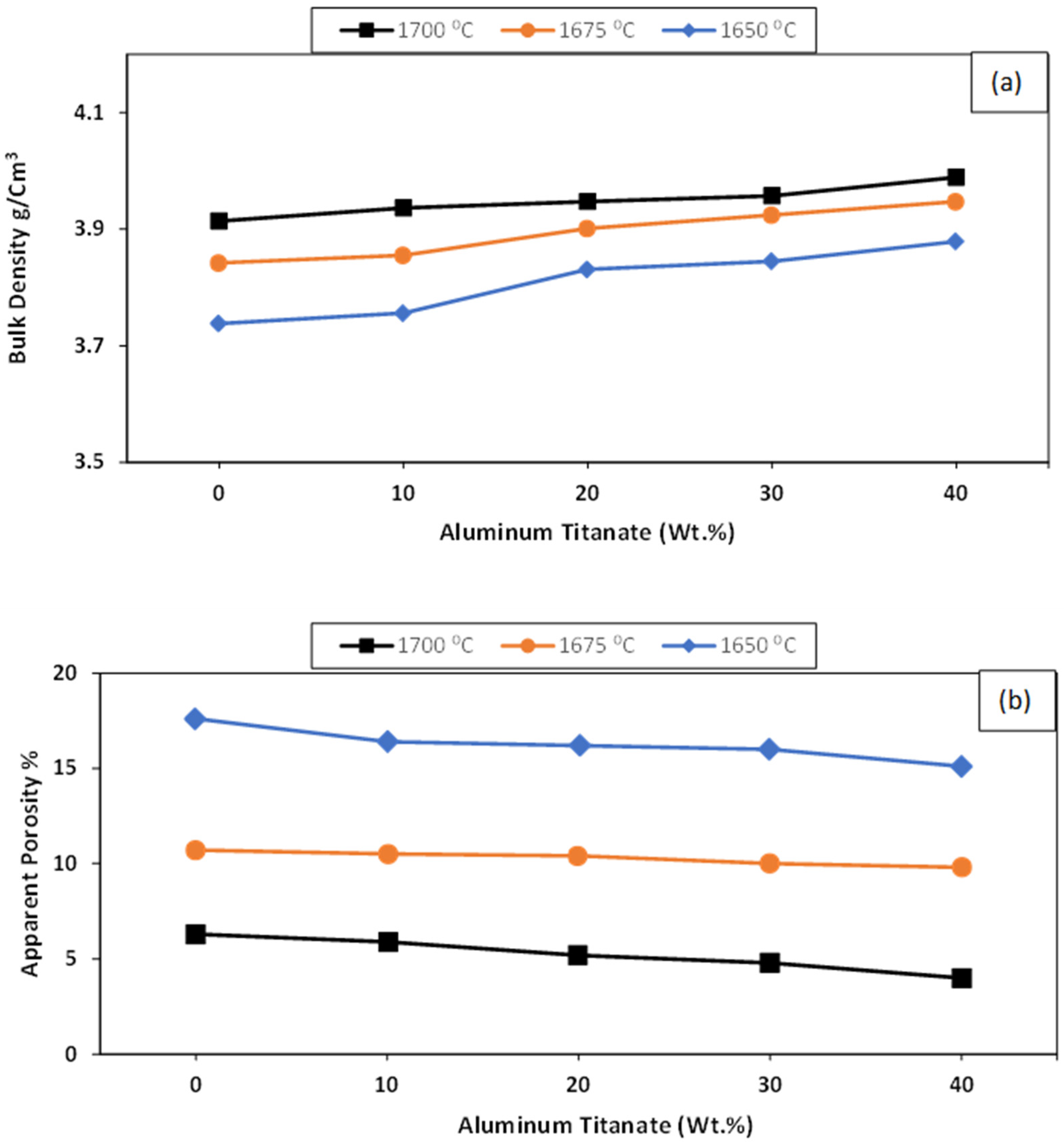



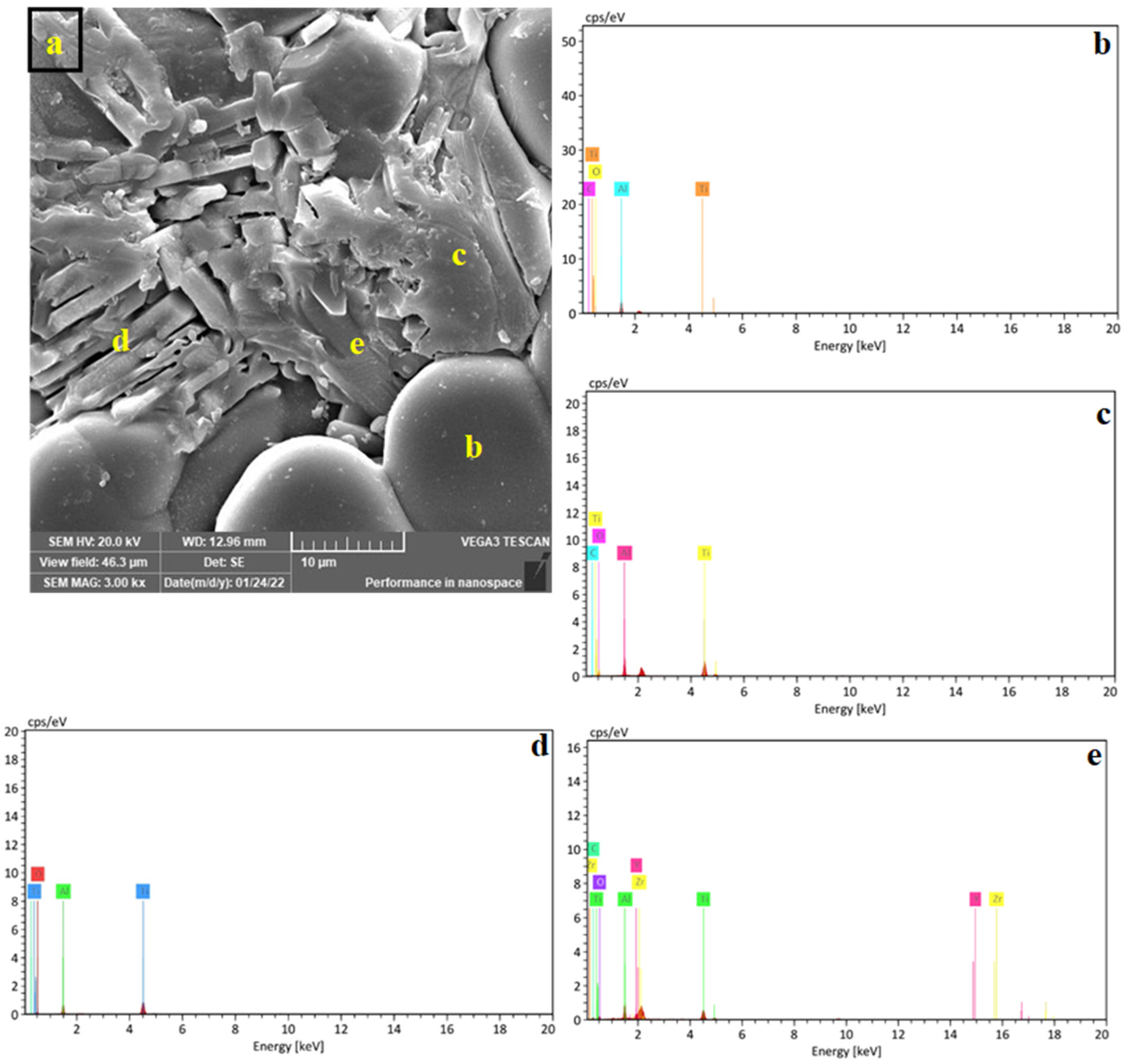
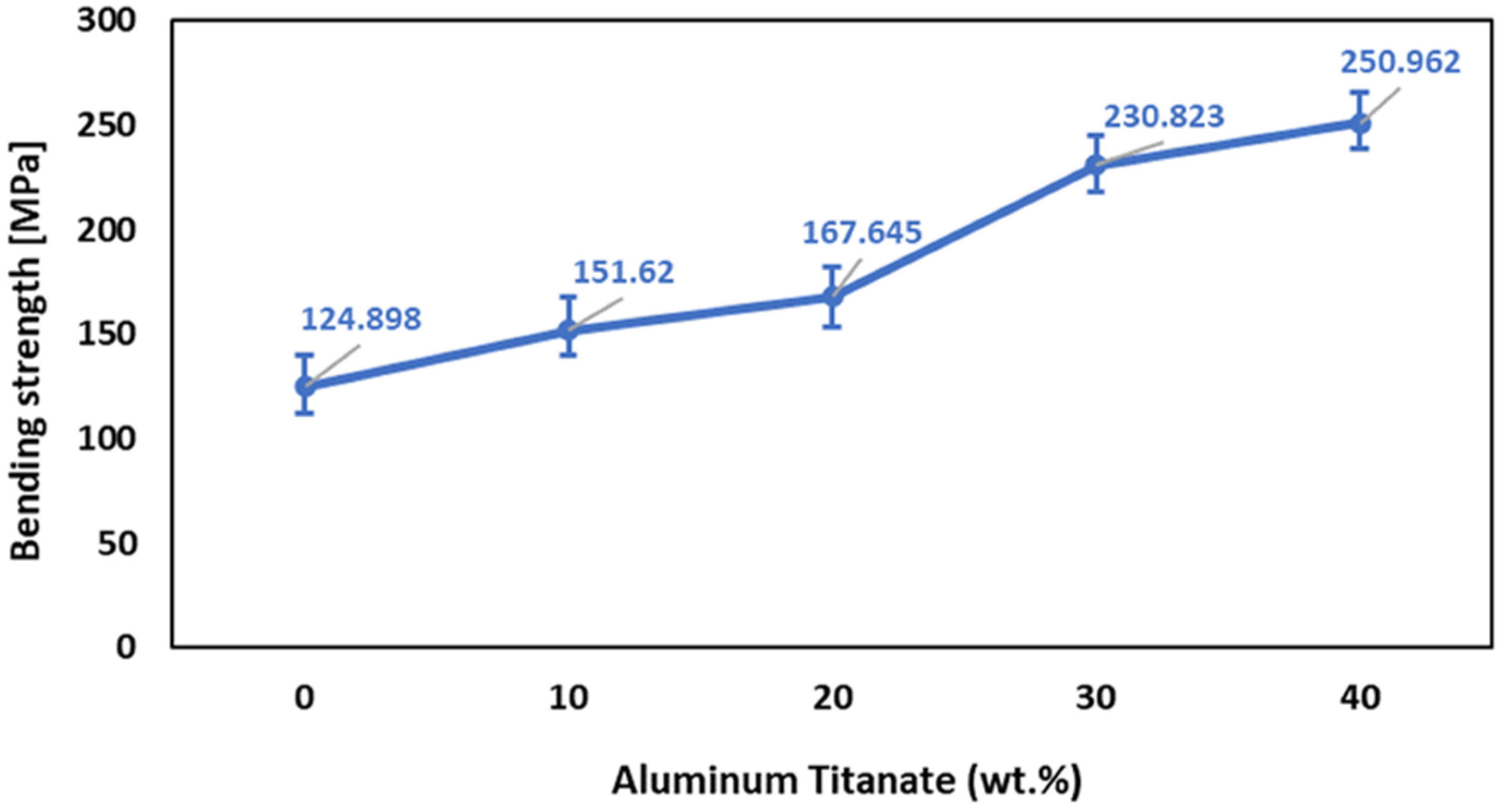



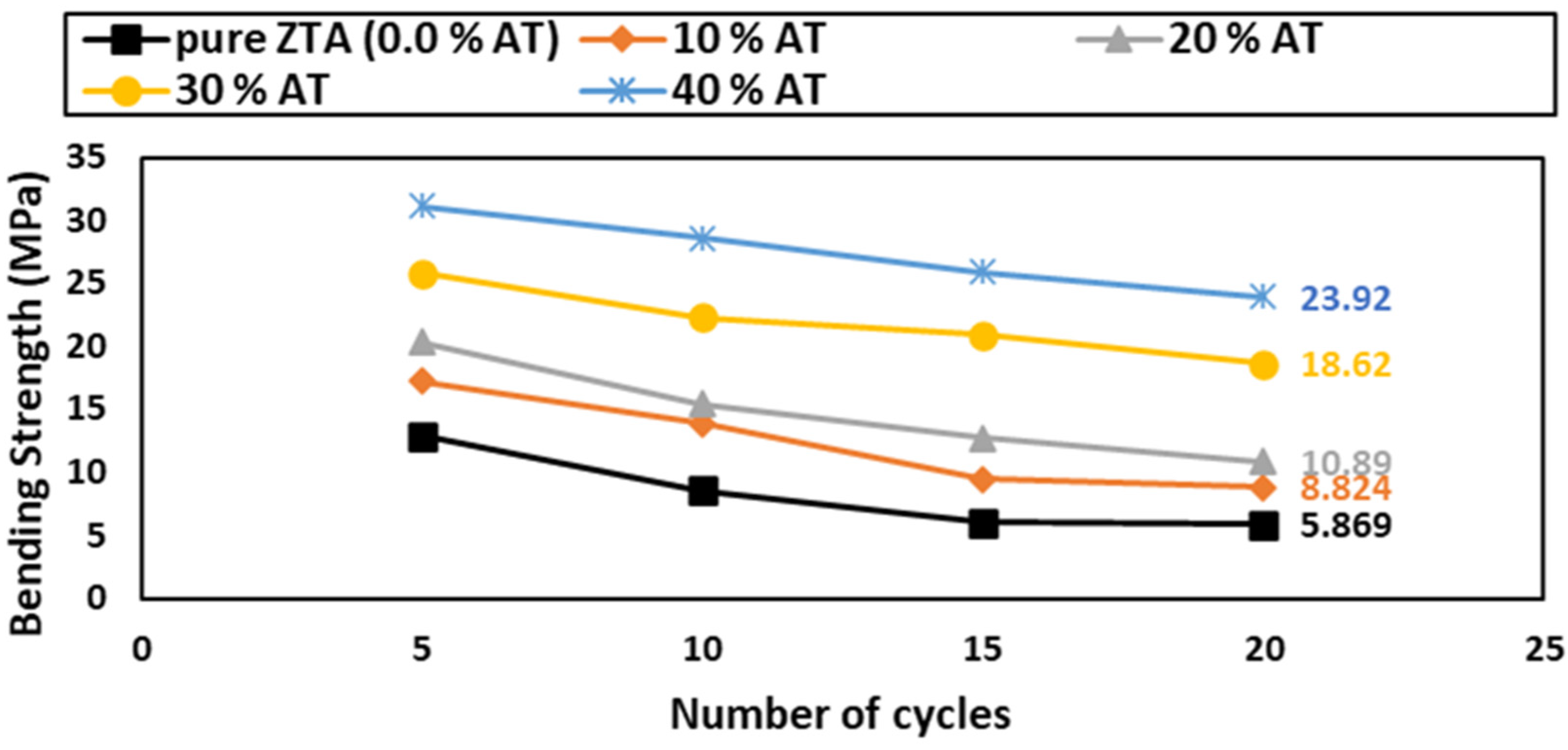
| Batch Symbol | Composition (wt%) | |
|---|---|---|
| ZTA | Al2TiO5 | |
| Z0 | 100 | 0 |
| Z1 | 90 | 10 |
| Z2 | 80 | 20 |
| Z3 | 70 | 30 |
| Z4 | 60 | 40 |
Disclaimer/Publisher’s Note: The statements, opinions and data contained in all publications are solely those of the individual author(s) and contributor(s) and not of MDPI and/or the editor(s). MDPI and/or the editor(s) disclaim responsibility for any injury to people or property resulting from any ideas, methods, instructions or products referred to in the content. |
© 2023 by the authors. Licensee MDPI, Basel, Switzerland. This article is an open access article distributed under the terms and conditions of the Creative Commons Attribution (CC BY) license (https://creativecommons.org/licenses/by/4.0/).
Share and Cite
Hassan, A.M.; Elsayed, H.; Awaad, M.; Saleh, A.M.; Naga, S.M. Microstructure, Mechanical and Thermal Properties of ZTA/Al2TiO5 Ceramic Composites. Ceramics 2023, 6, 1977-1990. https://doi.org/10.3390/ceramics6040121
Hassan AM, Elsayed H, Awaad M, Saleh AM, Naga SM. Microstructure, Mechanical and Thermal Properties of ZTA/Al2TiO5 Ceramic Composites. Ceramics. 2023; 6(4):1977-1990. https://doi.org/10.3390/ceramics6040121
Chicago/Turabian StyleHassan, A. M., Hamada Elsayed, M. Awaad, A. M. Saleh, and S. M. Naga. 2023. "Microstructure, Mechanical and Thermal Properties of ZTA/Al2TiO5 Ceramic Composites" Ceramics 6, no. 4: 1977-1990. https://doi.org/10.3390/ceramics6040121
APA StyleHassan, A. M., Elsayed, H., Awaad, M., Saleh, A. M., & Naga, S. M. (2023). Microstructure, Mechanical and Thermal Properties of ZTA/Al2TiO5 Ceramic Composites. Ceramics, 6(4), 1977-1990. https://doi.org/10.3390/ceramics6040121






